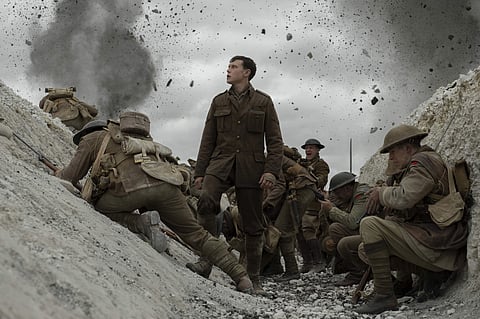1917 Movie Review: One of the greatest 'anti-war' films of all time
Rating:(4.5 / 5)
There is symmetrical beauty in how 1917 starts and ends. The green fields beaten down by the rays of the evening sun provide a warmth that promises a lush future in store. The blooming cherries provide a sense of calm. But more importantly, it is the eyes that are both closed and open at these differing points, that provide you with a pathway to gaze into the soul of those on screen. There, within those eyes, lie worlds. Behind those eyes, lie stories.
Life is a cycle of birth and death, according to religion. They say history repeats itself. Have you noticed how philosophical conversations have a cyclical nature about them? 1917 is a film that, at one particular midpoint, can begin to be seen as two distinct films. One which moves forward and one which moves backward. Both follow a circular trajectory, that is influenced by a clear up and down cycle, but both end at the start and begin at the end. The film is a bit like that mythical Norse beast Jörmungandr, the world serpent, which, when it leaves its grasp on its tail, triggers the start of Ragnarok, better known as the end of the world as we know it.
Cast: George McKay, Dean-Charles Chapman, Colin Firth, Benedict Cumberbatch, Mark Strong
Director: Sam Mendes
It is important to keep this in mind because a man, when pushed deep into the reality of war, faces his own mortality like none other. In the case of Lance Corporal Will Schofield (a brilliant George McKay), the world he knows is at its end. In the larger scheme of things, he is but an unnamed soldier but to him, his life is all there is. That is why he sells his valour medal for a piece of wine. "It is just a bloody tin," he quips. But to his companion Lance Corporal Tom Blake (Dean-Charles Chapman), "it might be just a bloody tin, but it has got a ribbon on it." In a crumbling world (literally and figuratively) around them, Will scoffs at this optimism. There is no place for it in war. "Hope is a dangerous thing," he reminds us, ominously, unlike how it’s contrastingly used in The Shawshank Redemption.
There is something both terrifyingly beautiful and beautifully terrifying about 1917. The soldier in the first world war was not only fighting the human but also the elements of nature itself. A momentous shot late in the movie comes when Schofield is looking at a town in flames. A town that when he entered was just filled with the human dead, the charred ground and worn down walls. As the screen fills with the blazing inferno, Schofield is transfixed in awe and shock in equal amounts. But what elevates this shot is the presence of a waterless fountain, which appears at once like both a chess piece as well as the holy cross. Is Schofield just a pawn in this long chess game? Or is he the hope and salvation that is passing through the fires of Hades to deliver upon the promised land?
For, Schofield and Blake are messengers. Like Pheidippides, they are tasked with covering the required distance on foot. Unlike the marathon runner though, theirs is not a message of victory, but of caution. While the narrative seems seemingly straightforward, the film is rarely but. Enough has been written about Roger Deakins over years but 1917 truly is a love letter by Deakins to cinema, and you could say, to himself and to the very craft of cinematography. Francois Truffaut once said that no war movie can truly be anti-war because even the latter kind of cinema still valorises combat subconsciously. Yet in Deakins’ work, you are but a mere watcher of the journey of two men who go beyond enemy lines to stop war from happening.
The camera nudges you. It wants you to look at two things on the screen at the same time. Yet when you do, the camera shudders wondering what is coming next. The camera raises its head ever so slightly to get a peek of what is to come. Yet it fully knows that when you raise your head, your immediate horizon widens significantly. One particular scene, with some of the best work in years from Thomas Newman, reminds you immediately of that ingenius shot in The Good, The Bad and The Ugly when Ecstasy of Gold debuts. The camera is not just Deakins. It is you. It is you who are transported to the trenches and the battlefields of World War I.
And it is precisely because of this reason that 1917 is so breathless and exhausting. When an unknown soldier sings in the woods behind the Hindenburg line, "I am a poor wayfaring stranger," I couldn't but help think of George RR Martin's famous monologue from A Feast of Crows, "The broken man lives from day to day, from meal to meal, more beast than man. In times like these, the traveller must beware of broken men, and fear them . . . but he should pity them as well." That the last refuge of empathy lies at the end of a barrel of gun is probably what makes living so frustrating but worthwhile too. It has been a century since the end of World War I, but love, more than fear, is still the greatest weapon in our arsenal. It’s wise to constantly remember that.

